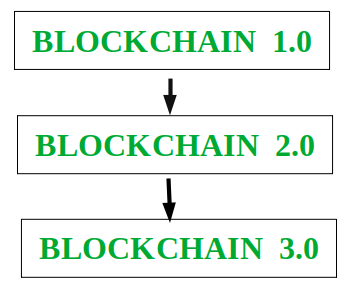Different Version of BlockChain
Last Updated :
27 Feb, 2023
BlockChain is buzzword in today’s technology. Thus, a BlockChain is defined as the digital record of transaction which is stored in the Chain of Blocks.

Each time a block is completed by storing Information, the next new block is created to store further information. BlockChain is a secure technology in which third party intermediary are not allowed. For example: in money transfer banks interference are not allowed. BlockChain technology is used in various fields like Banking, Finance, Government, Insurance, Healthcare, retail etc.
Different Versions of BlockChain :
There are Three Version’s of BlockChain as depicted below :

1. BlockChain 1.0 (Cryptocurrency) –
BlockChain Version 1.0 was introduced in 2005 by Hall Finley, who implements DLT (Distributed Ledger Technology) represents its first application based on Crypto currency. This allows Financial Transaction based on BlockChain technology or DTL which is executed with the help of BitCoin. This type of Version is permissionless as any participant will perform valid transaction of Bitcoin. This type is mainly used in Currency and Payments. Blockchain 1.0 or Blockchain Version 1.0 aimed to introduce a transparent, publicly accessible, completely decentralised, immutable ledger and distributed system of transactions in the global financial market. Blockchain 1.0 is developed over the idea and structure of Bitcoin. It primarily focused on the development and creation of new cryptocurrencies. Blockchain 1.0 is often termed a digital, decentralised, distributed ledger that records transactions in a database shared by all nodes, updated by blockchain miners and maintained and monitored by everyone with no individual ownership.
2. BlockChain 2.0 ( Smart Contracts) –
The new Version of BlockChain come because there is a problem in version 1.0 which was Mining of BitCoin was Wasteful and there was also lack of Scalability of Network in it. So problem is improved in Version 2.0. In this version, the BlockChain is not just limited to Cryptocurrencies but it will extend up to Smart Contracts.
Thus, Small Contracts are Small Computer’s which live in the Chains of Blocks. These Small Computer’s are free computer programs that executed automatically, and check the condition defined earlier like facilitation, verification or enforcement and reduce transactions cost efficiency.
In BlockChain 2.0, BitCoin is replaced with Ethereum. Thus, BlockChain 2.0 was successfully processing high number of Transactions on Public network rapidly.
3. BlockChain 3.0 (DApps) –
After Version 2.0, new version was introduced which includes DApps which is known as Decentralized Apps. A DApp is like a conventional app, it can have frontend written in any language that makes calls to its backend, and its backend code is running on decentralized Peer-To-Peer Network. It makes use of decentralized storage and communication which can be Ethereum Swarm etc. DApps is decentralised, i.e. no single owner/authority that ensures transparency, improved security, data accessible to all, no censorship and flexible development. DApps brings many benefits such as zero downtime, ensuring privacy, data integrity and trustless yet secure communication (business, transaction, etc.).
There are many decentralized Applications like BitMessage, BitTorrent, Tor, Popcorn, etc.
Advantages :
- Transaction takes place without requiring and Third Party Intermediary which ensures the security of Details and Data.
- BlockChain use Cryptography in order to make sure the information is locked inside the BlockChain.
- BlockChain removes Double records which accelerates Transactions.
Disadvantages :
- There is always risk of Error as long as human factor is evolved.
- Transaction cost of BitCoin is quite Higher.
- Blockchain technology is immutable it means we cannot make any changes when data or information is inserted.
Like Article
Suggest improvement
Share your thoughts in the comments
Please Login to comment...